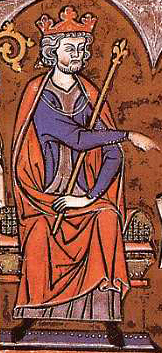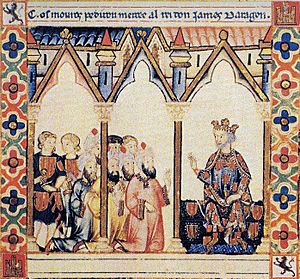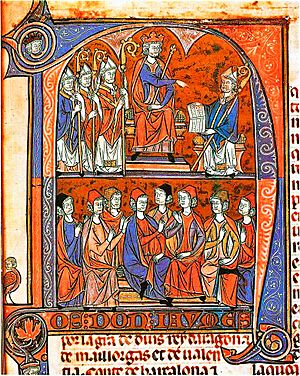James I of Aragon facts for kids
Quick facts for kids James I |
|
|---|---|

Detail from Vidal Mayor
|
|
| King of Aragon Count of Barcelona |
|
| Reign | 12 September 1213 – 27 July 1276 |
| Predecessor | Peter II |
| Successor | Peter III |
| Born | 2 February 1208 Montpellier |
| Died | 27 July 1276 (aged 68) Alzira, Valencia |
| Burial | Poblet Monastery |
| Spouse | Eleanor of Castile Violant of Hungary Teresa Gil de Vidaure |
| Issue among others... |
Violant, Queen of Castile Constance, Lady of Villena Peter III, King of Aragon James II, King of Majorca Isabella, Queen of France |
| House | Barcelona |
| Father | Peter II, King of Aragon |
| Mother | Maria of Montpellier |
| Religion | Roman Catholicism |
James I the Conqueror (Catalan: Jaume el Conqueridor; 2 February 1208 – 27 July 1276) was King of Aragon and Lord of Montpellier from 1213 to 1276; King of Majorca from 1231 to 1276; and Valencia from 1238 to 1276 and Count of Barcelona. His long reign—the longest of any Iberian monarch—saw the expansion of the Crown of Aragon in three directions: Languedoc to the north, the Balearic Islands to the southeast, and Valencia to the south. By a treaty with Louis IX of France, he achieved the renunciation of any possible claim of French suzerainty over the County of Barcelona and the other Catalan counties, while he renounced northward expansion and taking back the once Catalan territories in Occitania and vassal counties loyal to the County of Barcelona, lands that were lost by his father Peter II of Aragon in the Battle of Muret during the Albigensian Crusade and annexed by the Kingdom of France, and then decided to turn south. His great part in the Reconquista was similar in Mediterranean Spain to that of his contemporary Ferdinand III of Castile in Andalusia. One of the main reasons for this formal renunciation of most of the once Catalan territories in Languedoc and Occitania and any expansion into them is the fact that he was raised by the Knights Templar crusaders, who had defeated his father fighting for the Pope alongside the French, so it was effectively forbidden for him to try to maintain the traditional influence of the Count of Barcelona that previously existed in Occitania and Languedoc.
As a legislator and organiser, he occupies a high place among the European kings. James compiled the Llibre del Consolat de Mar, which governed maritime trade and helped establish Aragonese supremacy in the western Mediterranean. He was an important figure in the development of the Catalan language, sponsoring Catalan literature and writing a quasi-autobiographical chronicle of his reign: the Llibre dels fets.
Contents
Early life and reign until majority
James was born at Montpellier as the only son of Peter II of Aragon and Marie of Montpellier. As a child, James was made a pawn in the power politics of Provence, where his father was engaged in struggles helping the Cathar heretics of Albi against the Albigensian Crusaders led by Simon IV de Montfort, Earl of Leicester, who were trying to exterminate them. Peter endeavoured to placate the northern crusaders by arranging a marriage between his two-year-old son James and Simon's daughter. He entrusted the boy to be educated in Montfort's care in 1211, but was soon forced to take up arms against him, dying at the Battle of Muret on 12 September 1213. Montfort would willingly have used James as a means of extending his own power had not the Aragonese appealed to Pope Innocent III, who insisted that Montfort surrender him. James was handed over to the papal legate Peter of Benevento at Carcassonne in May or June 1214.
James was then sent to Monzón, where he was entrusted to the care of Guillem de Montredó, the head of the Knights Templar in Aragon and Provence; the regency meanwhile fell to his great-uncle Sancho, Count of Roussillon, and his son, the king's cousin, Nuño. The kingdom was given over to confusion until, in 1217, the Templars and some of the more loyal nobles brought the young king to Zaragoza.
In 1221, he was married to Eleanor, daughter of Alfonso VIII of Castile. The next six years of his reign were full of rebellions on the part of the nobles. By the Peace of Alcalá of 31 March 1227, the nobles and the king came to terms.
Acquisition of Urgell
In 1228, James faced the sternest opposition yet from a vassal. Guerau IV de Cabrera occupied the County of Urgell in opposition to Aurembiax, the heiress of Ermengol VIII, who had died without sons in 1208. Although Aurembiax's mother, Elvira, had made herself a protégée of James's father, upon her death in 1220 Guerau occupied the county and displaced Aurembiax, claiming that a woman could not inherit.
James intervened on behalf of Aurembiax, to whom he owed protection. He bought Guerau off and allowed Aurembiax to reclaim her territory, which she did at Lleida, probably also becoming one of James' earliest mistresses. She surrendered Lleida to James and agreed to hold Urgell in fief for him. On her death in 1231, James exchanged the Balearic Islands for Urgell with her widower, Peter of Portugal.
From 1230 to 1232, James negotiated with Sancho VII of Navarre, who desired his help against his nephew and closest living male relative, Theobald IV of Champagne. James and Sancho negotiated a treaty whereby James would inherit Navarre on the old Sancho's death, but when this occurred in 1234, the Navarrese nobles elevated Theobald to the throne instead, and James disputed it. Pope Gregory IX was required to intervene. In the end, James accepted Theobald's succession.
James endeavoured to form a state straddling the Pyrenees in order to counterbalance the power of France north of the river Loire. As with the much earlier Visigothic attempt, this policy was victim to physical, cultural, and political obstacles. As in the case of Navarre, he declined to launch into perilous adventures. By the Treaty of Corbeil, signed in May 1258, he ended his conflict with Louis IX of France, securing the renunciation of any French claims to sovereignty over Catalonia, including the County of Barcelona.
Reconquest

After his false start at uniting Aragon with the Kingdom of Navarre through a scheme of mutual adoption, James turned to the south and the Balearic Islands in the Mediterranean Sea. On 5 September 1229, the troops from Aragon, consisting of 155 ships, 1,500 horsemen and 15,000 soldiers, set sail from Tarragona, Salou, and Cambrils, in southern Catalonia, to conquer Majorca from Abu Yahya, the semi-independent Almohad governor of the island. Although a group of Aragonese knights took part in the campaign because of their obligations to the king, the conquest of Majorca was mainly a Catalan undertaking, and Catalans would later make up the majority of Majorca's settlers. James conquered Majorca on 31 December 1229, and Menorca (1232) and Ibiza (1235) were later acquired during the reconquest.
Valencia capitulated to Aragonese rule on 28 September 1238, following an extensive campaign that included the Siege of Burriana and the decisive Battle of the Puig, where the Aragonese commander, Bernat Guillem I d'Entença, who was also the king's cousin, died from wounds received in action. Chroniclers say he used gunpowder in the siege of Museros castle.
During his remaining two decades after Corbeil, James warred with the Moors in Murcia, on behalf of his son-in-law Alfonso X of Castile. On 26 March 1244, the two monarchs signed the Treaty of Almizra to establish their zones of expansion into Andalusia so as to prevent squabbling between them. Specifically, it defined the borders of the newly created Kingdom of Valencia. James signed it on that date, but Alfonso did not affirm it until much later. According to the treaty, all lands south of a line from Biar to Villajoyosa through Busot were reserved for Castile.
Crusade of 1269
Abaqa, the "Khan of Tartary" (actually the Ilkhan), corresponded with James in early 1267, inviting him to join forces with the Mongols and go on crusade. James sent an ambassador to Abaqa in the person of Jayme Alaric de Perpignan, who returned with a Mongol embassy in 1269. Pope Clement IV tried to dissuade James from crusading, regarding his moral character as sub-par, and Alfonso X did the same. Nonetheless, James, who was then campaigning in Murcia, made peace with Muhammad I, the Sultan of Granada, and set about collecting funds for a crusade. After organising the government for his absence and assembling a fleet at Barcelona in September 1269, he was ready to sail east. The troubadour Olivier lo Templier composed a song praising the voyage and hoping for its success. A storm, however, drove him off course, and he landed at Aigues-Mortes. According to the continuator of William of Tyre, he returned via Montpellier por l'amor de sa dame Berenguiere ("for the love of his lady Berengaria") and abandoned any further effort at a crusade.
James's sons Pedro Fernández and Fernán Sánchez, who had been given command of part of the fleet, did continue on their way to Acre, where they arrived in December. They found that Baibars, the Mameluke Sultan of Egypt, had broken his truce with the Kingdom of Jerusalem and was making a demonstration of his military power in front of Acre. During the demonstration, Egyptian troops hidden in the bushes ambushed a returning Frankish force that had been in Galilee. James's sons, initially eager for a fight, changed their minds after this spectacle and returned home via Sicily, where Fernán Sánchez was knighted by Charles of Anjou.
Patronage of art, learning, and literature
James built and consecrated the Cathedral of Lleida, which was constructed in a style transitional between Romanesque and Gothic with little influence from Moorish styles.
James was a patron of the University of Montpellier, which owed much of its development to his impetus. He also founded a studium at Valencia in 1245 and received privileges for it from Pope Innocent IV, but it did not develop as splendidly. In 1263, James presided over a debate in Barcelona between the Jewish rabbi Nahmanides and Pablo Christiani, a prominent converso.
James was the first great sponsor and patron of vernacular Catalan literature. Indeed, he may himself be called "the first of the Catalan prose writers." James wrote or dictated at various stages a chronicle of his own life in Catalan, Llibre dels fets, the first autobiography by a Christian king. As well as being a fine example of autobiography, the "Book of Deeds" expresses concepts of the power and purpose of monarchy, examples of loyalty and treachery in the feudal order, and medieval military tactics. More controversially, some historians have looked at these writings as a source of Catalan identity, separate from that of Occitania and Rome.
James also wrote the Libre de la Saviesa or "Book of Wisdom." The book contains proverbs from various authors, reaching from the time of King Solomon to nearly his own time with Albertus Magnus. It even contains maxims from the medieval Arab philosophers and from the Apophthegmata Philosophorum of Honein ben Ishak, which was probably translated at Barcelona during his reign. A Hebrew translator by the name of Jehuda was employed at James's court during this period.
Though James was himself a prose writer and sponsored mostly prose works, he had an appreciation of verse. In consequence of the Albigensian Crusade, many troubadours were forced to flee southern France and many found refuge in Aragon. Notwithstanding his early patronage of poetry, by the influence of his confessor Ramon de Penyafort, James brought the Inquisition into his realm in 1233 to prevent any vernacular translation of the Bible.
Succession
The favour James showed his illegitimate offspring led to protest from the nobles, and to conflicts between his legitimate and illegitimate sons. When one of the latter, Fernán Sánchez, who had behaved with gross ingratitude and treason toward his father, was slain by the legitimate son Peter, the old king recorded his grim satisfaction.
In his will, James divided his states between his sons by Yolanda of Hungary: the aforementioned Peter received the Hispanic possessions on the mainland and James received the Kingdom of Majorca, which included the Balearic Islands, the counties of Roussillon and Cerdanya, and the Lordship of Montpellier. The division inevitably produced fratricidal conflicts. In 1276, the king fell very ill at Alzira and resigned his crown, intending to retire to the monastery of Poblet, but he died at Valencia on 27 July.
His mummified body was later exhumed in 1856, when the monastery was under repair. A photograph of the king was taken.
Marriages and children
James first married, in 1221, Eleanor, daughter of Alfonso VIII of Castile and Eleanor of England. Though he later had the marriage annulled, his one son by her was declared legitimate:
- Alfonso (1229–1260), married Constance of Béarn, Viscountess of Marsan
In 1235, James remarried to Yolanda, daughter of Andrew II of Hungary by his second wife Yolande de Courtenay. She bore him numerous children:
- Yolanda, also known as Violant, (1236–1301), married Alfonso X of Castile
- Constance (1239–1269), married Manuel of Castile, son of Ferdinand III
- Peter III (1240–1285), successor in Aragon, Catalonia, and Valencia
- James II (1243–1311), successor in Balearics and Languedoc
- Ferdinand (1245–1250)
- Sancha (1246–before 1275), died in the Holy Land.
- Isabella (1248–1271), married Philip III of France
- Maria (1248–1267), nun
- Sancho (1250–1275), Archbishop of Toledo
- Eleanor (born 1251, died young)
James married thirdly Teresa Gil de Vidaure, but only by a private document, and left her when (as he claimed) she developed leprosy.
- James (c.1255–1285), lord of Xèrica
- Peter (1259–1318), lord of Ayerbe
The children in the third marriage were recognised in his last will as being in the line of succession to the throne, should the senior lines fail.
James also had several lovers, both during and after his marriages, and a few bore him illegitimate sons.
By Blanca d'Antillón:
- Fernán Sánchez (or Fernando Sánchez) (1240–1275), Baron of Castro
By Berenguela Fernández:
By Elvira Sarroca:
- Jaume Sarroca (born 1248), Bishop of Huesca from 1273 to 1290
See also
 In Spanish: Jaime I de Aragón para niños
In Spanish: Jaime I de Aragón para niños


